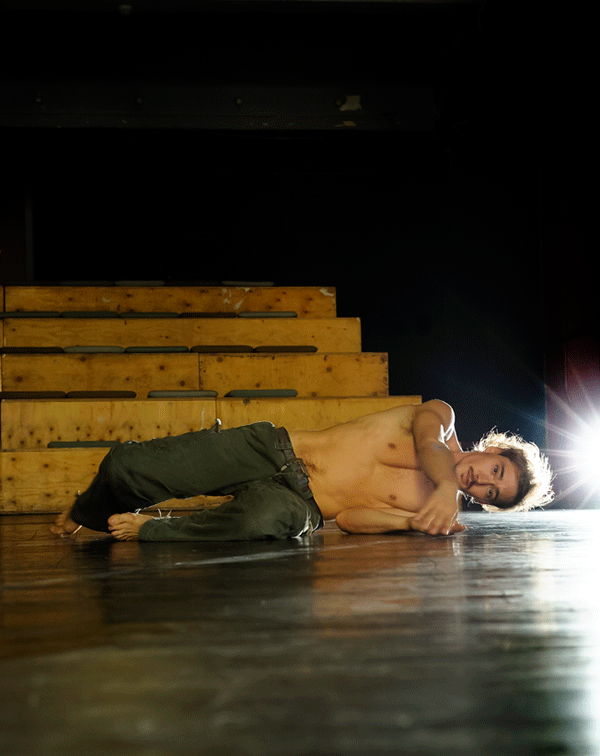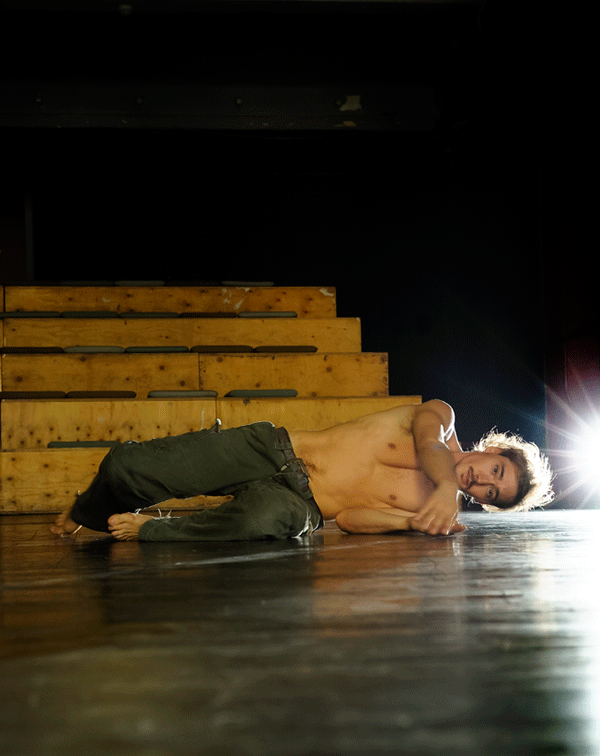Having graduated from the Circus School of Turin in Italy and the “SNDO” School in Amsterdam with a master in choreography and having worked on free artistic acrobat movement at the Le Lido School in Toulouse, the 28 years old Piergiorgio Milano, is considered one of the greatest Italian dancers and choreographers in modern dance, influenced by famous artists like David Zambranov, Sidy Larby Cherkaoui , Roberto Olivan and others. Occasioned by his awarded solo “Denti”, which opened on Athens Video Dance Project, Ozon Raw met him at the roof floor of Booze Cooperativa and unfolded all the struggles hidden in aspects of his life!
How did you decide to become a dancer?
When I was 16 I met two very good friends of mine, who were circus artists and they were traveling to their street shows. I decided to travel with them for a while more like a friend and somehow I got really touched by their work and especially by the way they were living their lives and the kind of human relationship they were able to establish through their work. The foundation of the first Circus School in Italy at Turin, found me finishing high-school. I was supposed to carry on with my studies at the University but the death of my father changed a lot of things in my family and even though they still wanted me to study at the University, I guess they didn’t have the strength or the will to insist on it till the end. I was accepted at the Circus School and from then on I started my artistic career.
Talk to me about your studies at the Circus School.
It was a very nice experience but at the beginning it requested from me a lot of discipline and devotion and I wasn’t much of a disciple guy at that time. After the first five months I started thinking about giving it up. At that time I met an actress from Naples. We were studying together at Circus School. She was a couple of years older and more focused at what she wanted to do, so she made me change my mind and carry on with my studies. After a while I began noticing how all that had changed me from bottom up. Not in the way I was thinking but in the way I was confronting life and her difficulties. After Circus School Ι continued my studies at Le Lido, Centre for Circus Arts in Toulouse, based more on personal artistic research and less in technique. The gold is to put the artist in a condition where one loses certainty of the things he knew when he entered the school, so as to create a free ground upon which you can build consciousness of what you do, because you lose your certainty and you need to find it again.
Had you ever watched any modern dance up to that time?
No but I was very lucky because at Le Lido I met a dancer , who already had professional experience on modern dance , he had worked with many companies and he showed me some works in videos. I really got amazed by them. At that time we were living in a caravan and I remember dancing just by watching those films. We were going out and we were throwing each other on the floor, we were running, we were climbing on trees. Not just for fun but because we were really feeling the need to do it. That same year the Centre of Choreography in Toulouse was firing the 20 years from its foundation and had organized a Dance Festival, inviting all the great dancers in the world. It was one of the greatest moments in contemporary dance history in Europe. That’s when I knew what I really wanted to do.
What urged you to create “Denti”?
That time found me at the end of a very important relationship for me and at the same time as a dancer I was really questioning a lot if this was what I had to do and why, cause I still hadn’t create anything by myself. It was a moment that I felt so sad and desperate, that I was just thinking there was no hope and no way out for me. Just complete darkness. That’s when I started to experience the strength that was really hidden in that feeling. It was a strange time for me because I was so sad and at the same time I was so powerful. In a way the fact that I had lost everything put me in a condition of not having anything to lose anymore. Somehow I started to like it and profit by it, by deciding to do whatever I was wishing to do, because what I was fighting for till that day was gone! So I said let’s take that personal feeling I had and create something for someone who fell and decided to stand up only to see himself falling and standing up again and again. Like an endless loop. That’s how this solo came out.
In Italian “Denti” means teeth. Why did you choose this title for the solo?
In Italy when someone dreams about losing teeth, it means that someone very important to you will either live or pass away. My grandma, who was form Sicily, believed very strong in all that, so in a way all these superstitious are very familiar to me. I like them a lot because I think they are very funny. We also use it as a phrase when someone doesn’t want to let go of something. As far as it concerns the physicality of the show, it was something I was researching and I called it “sensible stone”, hard and sharp like the teeth, which you can use to cause pain to someone (for example baiting him) or you can suffer great pain by.
What kind of battle is it hidden in the aspects of a coat?
During that difficult period of my life I was searching to find something that could be stuck on me all the time. Something like a snake, or a color spot, that could move upon me and surprise me. I tried many different objects and I ended up at the coat. I wanted to express emotions that one thinks he has left them behind only to find out, that they were hiding in one of the pockets of his coat…
What is the first thing the following words bring to your mind?
Love: a taxi that’s passing, a coincidence. Jealousy: stairs. Pain: In Brussels, where I live, you see objects thrown in the street, they look like trash, but if you try to move them you’ll find people sleeping inside. I call them “man objects”. Runaway: plain. Dance: sweat. Loss: blond hair, a doorbell, a temple, something you think you hear but it’s not there anymore. Desire: desire is myself.
Interview: Despina Ramantani | Photographer: Elina Giounanli





